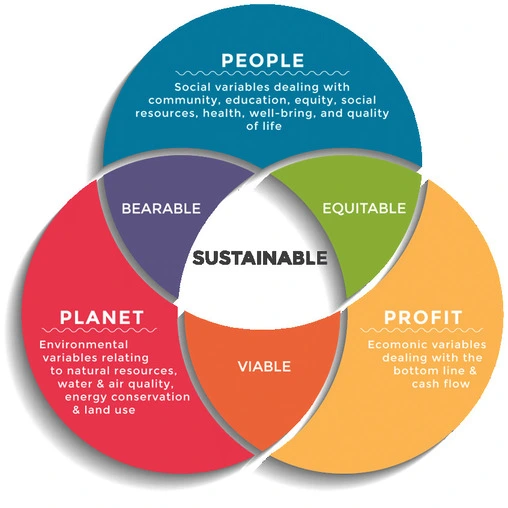In the annals of business history, the predominant focus has traditionally been on bolstering bottom lines and ensuring optimal financial performance for shareholders. However, a paradigm shift is underway as societal preferences evolve, with a growing inclination towards engaging with socially conscious companies. Contemporary consumers seek enterprises that not only generate profits but also contribute positively to society a shift encapsulated by the concept of the triple bottom line.
Defining the Triple Bottom Line
Coined by John Elkington in the mid-1990s, the triple bottom line signifies a departure from conventional accounting practices. Elkington sought to measure sustainability performance by expanding the accounting framework to encompass not only profits and shareholder value but also an organization’s environmental and social impact. It serves as a holistic marker, gauging a business’s effectiveness in meeting sustainability goals and envisaging the future of capitalism.
According to Andrew Savitz, principal consultant at Sustainable Business Strategies, the triple bottom line captures sustainability by measuring an organization’s impact on the world, incorporating both shareholder values and its social, human, and environmental capital. Avinash Chandra, founder and CEO of BrandLoom, emphasizes its essence as meeting present needs without jeopardizing the ability of future generations to meet their own.
The 3 P’s of the Triple Bottom Line
The triple bottom line, a sustainability-based accounting method, pivots on three pillars: people, planet, and profits. Often likened to a three-legged stool, these components collectively underpin the sustainable framework and distinguish it from traditional reporting approaches.
People
This dimension assesses a business’s impact on human capital. In adopting the triple bottom line, a company assumes responsibility not only to shareholders but also to employees, vendors, customers, and the broader community. It recognizes the interdependence of human relationships crucial to its operations, translating into actions such as offering quality employee benefits, fostering a safe work environment, and engaging in fair labor practices.
Planet
Companies adhering to the triple bottom line endeavor to minimize their ecological footprint. Recognizing that a reduced environmental impact extends a company’s operational longevity, initiatives range from using renewable energy sources to implementing green corporate policies. This commitment extends to safe disposal of toxic materials and ensuring that products do not compromise the health of the planet and its inhabitants.
Profits
While financial stability remains a universal business concern, companies dedicated to the triple bottom line view profits not only in terms of shareholder returns but also as a means to benefit the broader community. This model propels economic growth, wealth creation, and fair compensation for employees. Ethical decisions on sourcing materials, products, or labor underscore a commitment to responsible financial practices.
Benefits of the Triple Bottom Line
The triple bottom line, as a reporting tool, might not independently transform society or safeguard the environment. However, its real impact lies in driving positive change. A socially responsible model benefits both people and the planet, fostering goodwill, reducing disputes, and promoting economic growth.
Triple Bottom Line in Practice
Numerous businesses across industries incorporate triple bottom line principles into their operational frameworks:
1. Better World Books
This organization sells used books, donating a portion of profits to literacy programs and libraries, raising over $33 million and diverting millions of books from landfills.
2. DHL
This shipping giant prioritizes green initiatives, upgrading its delivery fleet to hybrid or alternative energy vehicles, supporting disaster management, and partnering with organizations to improve education for children.
3. Glassybaby
Selling hand-blown votives and glasses, this company donates $3 from each sale to charities through its Glassybaby White Light Fund, supporting cancer patients and nonprofit organizations.
4. Patagonia
An outdoor clothing manufacturer, Patagonia encourages customers to minimize environmental footprints, donates 10% of profits to environmental causes, runs a clothing repair facility, and invests in socially responsible startup companies.
5. South Mountain Company
An employee-owned architecture, engineering, and renewable energy firm committed to progressive business practices, it donates 10% of profits to charity and pro bono work, focuses on becoming a zero-net-energy and zero-waste business, and measures its overall carbon footprint.
Challenges of Measuring Impact
Measuring the environmental and social impact poses a significant challenge for the triple bottom line. While financial metrics are relatively straightforward, determining social capital is complex. Advocates propose monetizing all dimensions, yet objections exist, given the inherent value of ecosystems and biodiversity. Challenges also arise in justifying long-term benefits, such as reduced CO2 emissions or employee well-being, within shorter reporting cycles.
Study suggests the triple bottom line’s efficacy may hinge on developing a universal standard method and universally accepted measures for the three categories. The absence of a standardized approach means calculations will be driven by stakeholders, subject matter experts, and data availability, varying across companies. Ultimately, the triple bottom line’s success lies in its ability to evolve, adapt, and resonate with businesses committed to balancing profits with social and environmental responsibility

